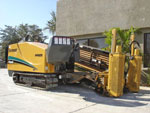What Does the International Market Offer?
By Bob Martin - General Manager - February 1, 2009 - Featured in Trenchless World Magazine
There is a wide selection of HDD drills offered from manufacturers based outside of the US. The quality ranges from next to useless to upper-end luxury, depending upon the manufacturer and the resources that they have to work with in their respective countries.
For the most part, drills can be categorized as coming from one of three locations: North America, Europe, or Asia. Each area has a stereotypical level of quality, performance and pricing. There are exceptions, of course, however for the most part, manufacturers from each area will fit fairly closely within the following norms.
North American machines have the benefit of a large amount of experience with HDD. The technology, to one extent or another, has been in place since the late 1970's and as a result, there has been a large amount of history and experience from which to draw upon. From a global standpoint, the North American manufactured drills are really the standard by which other drills are measured. The North American market is dominated by two or three major manufacturers, and their sales base is very globalized. The typical North American machine has high productivity and reliability, and has medium cost.
European drills have also been manufactured for a long period of time. Culturally, the typical European HDD machine is manufactured to very high standards and features a huge array of features vs. most other drills from other areas. As a result, productivity is typically high, however there is a tradeoff. With the high degree of automation, computer control and sensors that these machines utilize, diagnosing issues can be a costly endeavor, both in time and money. Cost is also a drawback, as these units are usually priced significantly higher than the comparable North American equivalent.
Asian machines are at the other end of the spectrum. The Asian HDD market is really still in its infancy, but a high investment of equipment from North American manufacturers into these areas has given them a huge base of equipment to draw knowledge from. For the most part, Asian manufacturers utilize very little innovation, instead pulling parts, components and designs from other industries and adapting them to the HDD market. There are a huge number of manufacturers in Asia, dominated by perhaps a half dozen major companies. For the most part, Asian machines have historically had very low productivity and very low reliability. There is still a booming market in Asia for used North American machines with the local contractors there willing to pay almost double the price instead of buying a new Asian-made drill. On the other hand, the prices for Asian machines are very low, averaging 30 to 40% of the price of the North American equivalence.
I have recently had the opportunity to take a very close look at the current offerings of HDD equipment out of China, and I think they bear special mention. There is a stereotypical machine that people envision when they think of a Chinese-made HDD drill. These machines were of low quality, typically built with sub-standard steel and made with components garnered from other industries. They were extremely simple designs copied from some of the more successful North American designs. They were plagued by issues that typically revolved around sub-standard quality control and inferior raw materials.
There is a difference, however, between what was being produced and what is now being made. Some of the new Chinese machines feature North American manufactured major components such as engines, pumps, motors and gearboxes that are assembled with Chinese labor. These units are seeing much higher productivity and reliability than the earlier drills could provide. They are still plagued somewhat by quality control issues, however that is changing and many of the manufacturers are applying for and obtaining ISO certification for their plants. These units are still relatively simple compared to current offerings from the major North American manufacturers, however the upside to this is that repair and maintenance is greatly simplified and many contractors can take these duties on in house. Certain manufacturers are approaching the quality and reliability of machines constructed in the late-1990's or early 2000's.
The new generation of Chinese manufactured equipment is routinely pricing in at 50 to 60% of the cost of their North American counterparts. Keep in mind that the features of the Chinese machines are typically not comparable with the major manufacturer here in North America. Chinese machines are very simple and are not as productive or smooth in operation as modern North American rigs.
In summary, I believe that the Asian and Chinese drills will become a definite force to be reckoned with in the very near future. For good or for bad, they will be showing up in the North American Market, and that will happen very soon. The manufacturers there have learned valuable lessons in regards to what the market is demanding, and they are scrambling to create equipment that fills that demand.
I will watch with great interest what the future has in store for the HDD-equipment industry.

This commentary is presented for informational purposes only. It is not intended to be a comprehensive or detailed statement on any subject and no representations or warranties, express or implied, are made as to its accuracy, timeliness or completeness. Nothing in this commentary is intended to provide financial, legal, accounting or tax advice nor should it be relied upon. Neither HDD Broker LLC nor the author is liable whatsoever for any loss or damage caused by, or resulting from, any use of or any inaccuracies, errors or omissions in the information provided.


